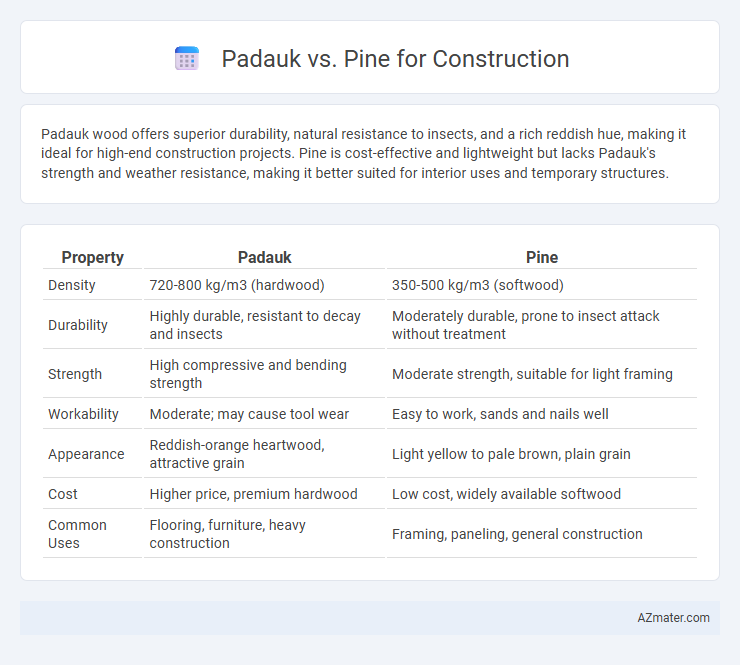Padauk wood offers superior durability, natural resistance to insects, and a rich reddish hue, making it ideal for high-end construction projects. Pine is cost-effective and lightweight but lacks Padauk's strength and weather resistance, making it better suited for interior uses and temporary structures.
Table of Comparison
| Property | Padauk | Pine |
|---|---|---|
| Density | 720-800 kg/m3 (hardwood) | 350-500 kg/m3 (softwood) |
| Durability | Highly durable, resistant to decay and insects | Moderately durable, prone to insect attack without treatment |
| Strength | High compressive and bending strength | Moderate strength, suitable for light framing |
| Workability | Moderate; may cause tool wear | Easy to work, sands and nails well |
| Appearance | Reddish-orange heartwood, attractive grain | Light yellow to pale brown, plain grain |
| Cost | Higher price, premium hardwood | Low cost, widely available softwood |
| Common Uses | Flooring, furniture, heavy construction | Framing, paneling, general construction |
Introduction to Padauk and Pine Woods
Padauk wood, known for its vibrant reddish-orange color and exceptional durability, is a hardwood commonly used in heavy construction and fine woodworking due to its resistance to decay and insects. Pine wood, characterized by its lighter color and softer texture, is a softwood frequently utilized in framing, interior finishes, and furniture because of its affordability and ease of handling. Both woods offer distinct advantages, with padauk providing superior strength and longevity, while pine allows for faster construction and cost efficiency.
Physical Properties Comparison
Padauk wood exhibits a higher density, typically around 640-850 kg/m3, compared to Pine's lighter density of approximately 350-550 kg/m3, resulting in greater strength and durability for heavy construction projects. The Janka hardness of Padauk ranges from 1600 to 2000 lbs, significantly outmatching Pine's Janka hardness of about 380 to 870 lbs, indicating superior resistance to wear and indentation. Padauk also offers excellent natural decay resistance and dimensional stability, making it ideal for outdoor and high-stress applications, whereas Pine is more prone to warping and decay unless properly treated.
Durability and Longevity
Padauk wood exhibits superior durability and longevity compared to pine, making it an excellent choice for construction projects requiring long-lasting materials. Its natural resistance to decay, insects, and moisture ensures structural integrity over extended periods, often exceeding several decades without significant degradation. In contrast, pine tends to be softer and more susceptible to rot and insect damage, necessitating frequent treatments and maintenance to achieve comparable lifespan.
Strength and Load-Bearing Capacity
Padauk wood exhibits superior strength and load-bearing capacity compared to pine, making it an ideal choice for heavy-duty construction projects where durability is critical. The high density and hardness of Padauk provide excellent resistance to bending and compression under load, outperforming the softer and more flexible pine wood. Pine, while easier to work with and more cost-effective, is better suited for lighter structural applications due to its comparatively lower mechanical strength.
Resistance to Insects and Decay
Padauk wood exhibits superior resistance to insects and decay due to its natural oils and dense grain, making it highly durable for construction in harsh environments. Pine, while more affordable and easier to work with, is more susceptible to insect infestation and fungal decay unless chemically treated. For long-term structural applications requiring robustness against biological threats, Padauk presents a more reliable option compared to untreated Pine.
Workability and Finishing
Padauk wood offers superior workability with its fine, even texture and natural resistance to splitting, making it ideal for precise cuts and detailed joinery. Pine, while softer and easier to machine, tends to splinter and dent more easily, requiring careful handling during construction. In terms of finishing, Padauk's vibrant reddish-orange hue deepens beautifully with oil or varnish, providing a long-lasting, rich look, whereas Pine's lighter tone often benefits from staining to achieve a more polished appearance.
Cost and Availability
Padauk wood, known for its durability and rich reddish hue, typically costs more than Pine due to its limited availability and slower growth rate, making it a premium choice in construction projects. Pine is widely available and grows rapidly, resulting in a lower price point and easy accessibility for large-scale construction and framing. Choosing between Padauk and Pine often depends on budget constraints and the need for aesthetic appeal or enhanced durability in specific construction applications.
Environmental Impact and Sustainability
Padauk wood, known for its natural durability and resistance to pests, requires less chemical treatment compared to pine, reducing environmental toxins during construction. Pine, being a fast-growing softwood, supports sustainable forestry practices due to its rapid replenishment, but often involves chemical preservatives to enhance durability. The choice between Padauk and Pine significantly influences the environmental footprint of construction projects, balancing natural longevity with renewable resource management.
Popular Construction Applications
Padauk wood is highly valued in construction for its exceptional durability and resistance to decay, making it ideal for outdoor projects like decking, flooring, and heavy structural components where longevity is critical. Pine, being softer and more affordable, is commonly used for framing, interior walls, and temporary structures, with a fast growth cycle supporting sustainable large-scale construction needs. Both woods serve distinct purposes; Padauk excels in applications requiring strength and weather resistance, while Pine is preferred for cost-effective, versatile interior construction.
Choosing the Right Wood for Your Project
Padauk offers exceptional durability and natural resistance to decay, making it ideal for outdoor construction and high-traffic areas. Pine is a cost-effective, versatile softwood widely used for framing and interior projects, but it requires treatment for enhanced longevity. Selecting Padauk ensures long-term strength and a rich, reddish hue, whereas Pine is preferable for budget-friendly applications with straightforward workability.

Infographic: Padauk vs Pine for Construction
 azmater.com
azmater.com